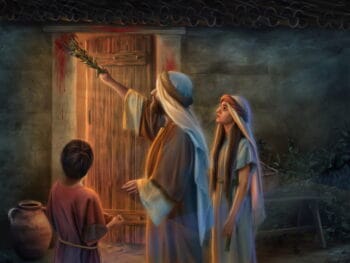Daily Lesson for Tuesday 29th of July 2025
Read Exodus 12:17-23. What role does blood play in the celebration of this new festival?
The blood of the sacrificed animal is a key element in this celebration. Those who participated in this feast had put the blood of the slain lamb on the doorframes of their houses. In this way, they demonstrated their faith in God, believing that He would deliver them from what those not covered by the blood would face.
What a powerful expression of the gospel!
The Passover lamb had to be without blemish because it pointed to Jesus Christ, “ ‘the Lamb of God who takes away the sin of the world!’ ” (John 1:29, NKJV). The animal’s blood played a crucial role: it symbolized protection and was the sign of life at a time of death.
“ ‘ “Now the blood shall be a sign for you on the houses where you are. And when I see the blood, I will pass over you; and the plague shall not be on you to destroy you when I strike the land of Egypt” ’ ” (Exodus 12:13, NKJV).
The whole gospel was associated with the celebration of the Passover because it pointed not only to freedom from slavery and going to the Promised Land but to Jesus Christ’s sacrifice for our sins and His merits applied to all who are covered by His blood.
Centuries later as Paul looked back on this celebration, he wrote: “Therefore purge out the old leaven, that you may be a new lump, since you truly are unleavened. For indeed Christ, our Passover, was sacrificed for us” (1 Corinthians 5:7, NKJV).
Yeast, or leaven, was used to prepare dough of various kinds. When it is first mentioned in the Bible, it is in connection with the preparation of the unleavened bread on the eve of the Israelites’ departure from Egypt. Yeast also had to be removed from their homes (Exodus 12:8,15-20; Exodus 13:3-7). In this particular context, yeast was a symbol of sin (1 Corinthians 5:6-8); therefore, it was not to be used during the Passover festival for a week.
The unleavened bread is a symbol of the sinless Messiah, who overcame all temptations and gave His life for us (John 1:29, 1 Corinthians 5:7, Hebrews 4:15). A bunch of “hyssop,” which was dipped in the blood, symbolized God’s purifying grace (Psalms 51:7). In short, all through Pesach, the redeeming work of Jesus is revealed.
|
What does the fact that it took the blood of Jesus, God Himself, to atone for sin to teach us about how bad sin really is? |
 (0)
(0)



